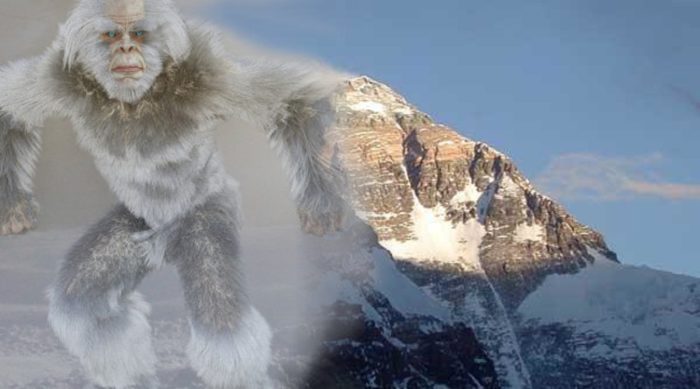
The Yeti – The “Other” Bigfoot: The Legends, Origins, And Sightings
- By
- December 7, 2020
- September 29, 2021
- 12 min read
- 1
- Posted in
- Cryptozoology, Bigfoot Encounters
We have touched on accounts of Bigfoot in the cold regions of Russia and Siberia in our in-depth article, The Bigfoot Files. However, the Yeti (often called the Abominable Snowman or even the “Russian Bigfoot) deserves a lengthy examination in its own right.
We perhaps should note, then, that while research into the Yeti often falls into the category of the “Russian Bigfoot”, in all likelihood the almost identical creatures from The Himalayas and mountainous regions of Asia, including parts of China and even Japan, are likely the same creature. For our purposes here, we will examine accounts from all of these regions. After all, such a creature as Bigfoot is unlikely to be respectful of international boundaries. It is also worth noting that for a large chunk of the 20th century the Soviet Union was essentially in control of much more territory than it is now.

The Yeti – the other Bigfoot
While many people dismiss claims of Bigfoot encounters, there is perhaps much more to examine in them than we might think. In fact, even Sir David Attenborough, after pointing to several discoveries of fossils with huge molars, stated that he believed the “Abominable Snowman may be real!” And what’s more, he pointed to the Himalayas and the “immense rhododendron forest that goes on for hundreds of square miles could hold the Yeti”. He would continue that “if there are some alive, and you walked by their habitat, you can bet these creatures may be aware of you, but you wouldn’t be aware of them!”
It is arguably a certainly that a connection exists between the Bigfoot or Sasquatch creatures of the North American continent and the Yetis of the Siberian and Asian regions. And while many Bigfoot researchers concentrate on the sightings in North America, there is an abundance of encounters of strange, hairy, beast-like creatures in the mountains and woodlands on the other side of the world. And what’s more, they stretch back hundreds of years, at the very least.
Contents
A Sudden Explosion Of Interest In The 1950s
It is perhaps best that we remind ourselves briefly of how the idea of a Russian Bigfoot and the connection to the Abominable Snowman first entered the public arena – at least in a widespread sense – in the 1950s.
We have examined briefly before the photographs of English mountaineer, Eric Shipton, who in 1951 while leading a research mission to Mount Everest would discover a particularly large human-like footprint in the snow. And what’s more, this discovery came somewhere in the region of 20,000 feet above sea level.
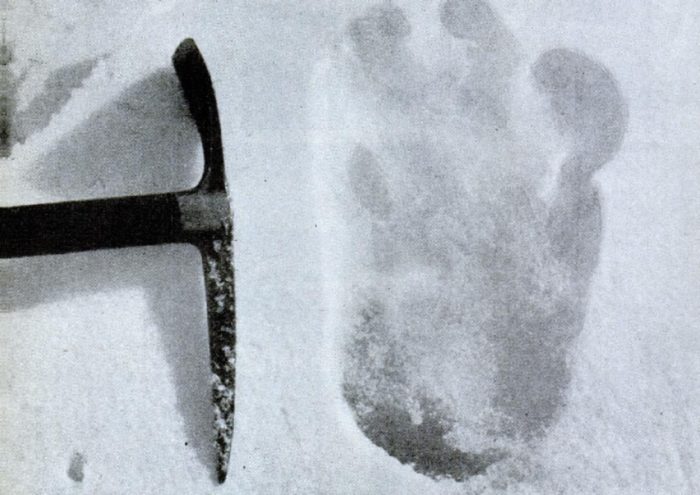
Eric Shipton’s discovered Yeti footprint
He would not only photograph them but would do so with his pick-ax beside them so as to leave no debate as to the true size of them. These pictures would ignite an interest in the wider public arena after sightings until that point, as we shall discover, were largely kept within the realms of those with an interest in such matters.
Further discoveries of these strange footprints would surface in various publications over the years that would follow. Perhaps one of the most intriguing was that led by John Angelo Jackson for the 1954 Daily Mail Snowman Expedition. He would photograph similar footprints, as well as discovering strange depictions of the apparent Yeti from ancient times that suggested these creatures had roamed this terrain for hundreds, perhaps thousands of years.
Connections To The Dyatlov Pass Incident?
The Dyatlov Pass Incident is also something that we have examined in-depth previously – the deaths of nine experienced mountain hikers in the most mysterious of circumstances. However, it is worth going over some of the apparent connections to this beast-like creature and the grim fate of the unfortunate hikers.
Perhaps the most compelling connection is one of the photographs discovered on one of the hiker’s cameras. It has since become known as Frame 17. This picture shows a figure seemingly looking down on the group and watching them. While many have stated it appears to show nothing more than a person in a hooded coat (most likely one of the hikers themselves), others point to the genuine Bigfoot-like appearance.
It is easy to dismiss such claims. However, when we know that the region of the mountains the hikers were in has a long history of Bigfoot sightings, both before and after the Dyatlov Pass incident, then such assertions appear a little more credible, if only slightly.
In fact, the Mansi people, who have lived in the region for centuries, speak of a beast-like creature almost identical to what we would recognize as a Bigfoot called a Menk. However, this creature is not merely a flesh and blood creature, but a supernatural being.
What is interesting here is that some researchers have also pointed to a supernatural connection to the Bigfoot sightings of North America. And even more intriguing, many of the Native tribes of the continent, like the Mansi people, also speak of a creature very similar to the Menk.
Early Accounts Of “The Yeti” Or “Abominable Snowman”
Although they are not as widely known, there are plenty of accounts of the Yeti that go back to at least the early 1800s, with some going back even further than that. One of these can be found in the book Yeti, Sasquatch and Hairy Giants by David Hatcher Childress.
The account in question goes all the way back to the time of Alexander the Great in 326 BC during his invasion of India. [1] While documenting a journey to the Indus River, the ancient writing (Anabasis Alexandri: Book VIII by Arrian) speaks of a battle with “hairy men” in a region called Tomerus. These natives were first noticed along the bank of the water living in “stifling cabins”.
Following a battle, during which several of these natives were captured (many escaped to the hills), it was noted that they “were hairy, not only their heads but the rest of their bodies”. Furthermore, they had “nails rather like beasts’ claws”. It was also noted that they wore “skins of animals” for clothing.
There is also a similar description to be found in the writings of Claudius Aelianus in the book De Natura Animalium (On The Nature Of Animals) who wrote in the early 200s BC of a Yeti-like creature in the mountains and valleys of India.
He refers to these creatures as “Satyrs” and describes them as being “covered with shaggy hair”. He elaborates that “when left to themselves, they stay in the forest and eat tree sprouts”. However, upon hearing the approach of people “they run with incredible speed to hide in mountain caves”. Perhaps of most interest, is the line that they “repel approaching humans by hurling stones down at them”. Many accounts – of Bigfoot and Yetis – feature this particular detail.
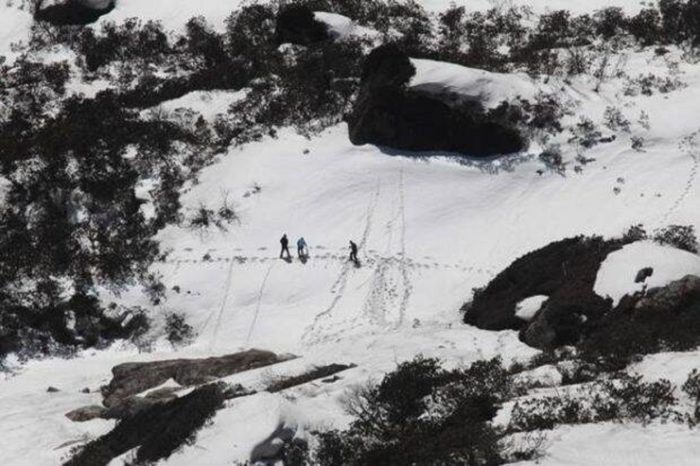
The mountainous regions of the Himalayas
In the book Bigfoot by Rupert Matthews, and much more recently (comparatively speaking) we can find further accounts. For example, respected hill walker, B.H. Hodgson would tell of an account that unfolded in Nepal in 1825. [2] Although he didn’t see the creature himself, his porters would report to him of seeing a “tall creature covered with long, dark hair”. Once this unnerving beast noticed it was being watched it “bounded off in apparent fear”.
Another account comes from the Mountains of Sikkim in northern India in 1889. According to Major L.A. Waddell, while on an expedition to map the region, he suddenly noticed footprints that “seemed to be those of a barefooted man with enormous feet”. When he consulted with his guide of the region, he was informed that they were the footprints of “the wild hairy man”. And perhaps more worrying, that they should cease following them and leave the area.
The Account Of William Knight
A similar incident unfolded in the 1890s, although it remained out of the public arena for three decades when The Times received a letter telling of it in the 1920s. The letter came from one William Knight, who was in Sikkim, traveling from Tantok to Sedonchen. During this journey, he decided to stop for a moment in order to allow his horse to rest. It was then that heard something behind him, seemingly coming from the woodland behind where he sat.
He would write in the letter that “some 20 paces away” he noticed a strange creature that he immediately assumed was “one of the hairy men that the Tibetans call the Abominable Snowman”. He would estimate the creature was over six feet tall and unclothed, in spite of the “bitter cold”.
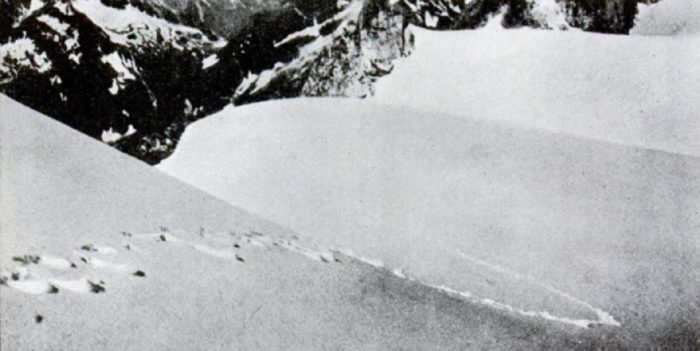
Are these footprints from a yeti?
Although he would describe the creature as “one of the hairy men”, he also claimed that this creature had “pale yellow” skin with significantly more hair on the head than elsewhere on the body. Knight would also state that this figure had “some form of primitive bow” in his hand. He would continue to watch the figure for around five minutes until it suddenly took off down the hill at “tremendous speed”.
Whether what Knight witnessed was a Bigfoot-like creature, or whether, as Matthews wrote was, in fact, “one of the unfortunate individuals that are driven from their families and villages to live wild and solitary lives in the wilderness” or not is perhaps open to debate (although, in this case, the latter is indeed more likely).
Interest Grows In The Early Decades Of The 1900s
There are further accounts from the early years of the 20th century. For example, at some time in the opening years of the 1900s, an incident is on record involving the daughter of a colonial military officer, Mary MacDonald. On this particular day, along with a team of porters, she was walking along a mountain trail near the Tibetan border.
Suddenly, the serene atmosphere of the environment was interrupted by a loud cry that ended on a monstrous growl. The perplexed young woman immediately turned around to ask her guide what the noise was. However, upon doing so she saw the team of porters running in the opposite direction, the equipment they were carrying abandoned on the spot.
She reached for one of the guns and then set off in the same direction as the porter team. When they felt they were sufficiently enough away, the men informed MacDonald that the call belonged to a “Metoh Kangmi”, which when translated meant “Bad Man of the Snow”.
This name would come up again around 20 years later, only this time the translation arrived at was slightly different – and it would stick. While looking to scout out Mount Everest, Colonel Howard-Bury was informed by his guide team of the same creature upon discovering huge human-like footprints in the snow. However, Howard-Bury would translate the name as “Abominable Snowman”. By the time the name appeared in print, it was almost an automatic moniker in the northern regions of India among English-speaking communities.
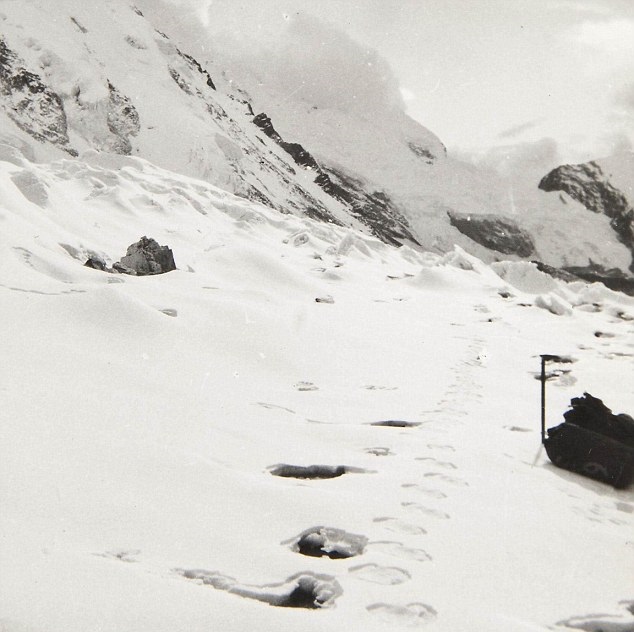
Are these footprints in the snow of a yeti?
Of course, as we know, several decades later upon the discovery of the footprints by Eric Shipton the name would reach a much wider audience.
In his book Yeti: An Abominable History, Graham Hoyland recounts another intriguing encounter that occurred in 1925 [3] when Narik Tombazi was studying glaciers in northern Sikkim. While doing so he suddenly noticed a strange human-like figure below him around 300 yards away from him. However, it was completely covered in hair. It appeared to be looking for vegetation to eat, even pulling up a small bush in order to gnaw at the roots.
After the creature had disappeared back into the woodland, Tombazi and members of his team went to the location where the creature was spotted. They would discover large footprints in the snow. Although Tombazi would ultimately decide that the creature must have been a “wandering pilgrim”, it was obvious that the more western explorers ventured into these seemingly uninhabited terrains, that sightings of the strange hairy creatures appeared to increase.
In fact, as the 1920s and 30s unfolded, there was a quiet interest in the strange beast-like creatures that walked these Eurasia regions. However, the outbreak of the Second World War suddenly halted such interest. And while, as we know, some researchers returned as the 1950s got underway, the height of public interest did not return to the levels before the war.
Much Later Sightings Of The Yeti
While we have examined some of the better-known incidents and discoveries up to the 1950s, sightings of the Yeti would continue as the decades went on.
For example, in 1970, while camping on an open slope at some 13,000 feet, Don Whillans noticed a strange creature appear from out of the woodland nearby. As the night was a clear one, he had no trouble at all seeing the incident unfold under the moonlight, even though he used his binoculars to do so.
He would state that this creature, while as tall as an average person, was much wider and heavy set and covered in fur or hair. What’s more, it moved around at a considerable pace using all fours like a monkey. He continued to watch for around an hour before the creature suddenly disappeared into the woodlands from where it had first emerged.
A similar incident occurred in 1972, this time in the Arun Valley. One evening, in the campsite of a zoological research team, a strange, hairy creature appeared out of nowhere during the evening, roaming between the tents. Each member of the research team believed that the creature was likely a bear so they remained still waiting for it to lose interest and leave. When they finally emerged from the tents, though, the large footprints left in the ground were far from bear-like.
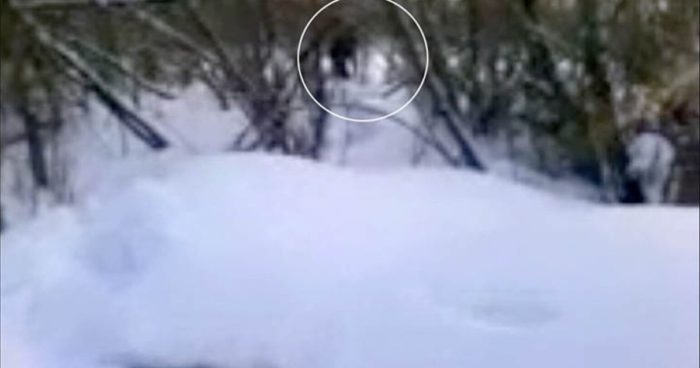
Is this a Yeti circled in white?
Perhaps an even spookier incident occurred a little after a decade later in 1984 when mountaineer, David Sheppard, noticed a strange, human-like figure covered in hair, seemingly following him for some time.
Of course, these sightings have continued right into the modern age. And as technology gets better, the chances to capture these strange creatures on video or photograph increases.
There have been many modern incidents and sightings of Yetis and Bigfoot creatures throughout the Eurasia region. Many of which have been captured on video. One of the most recent went particularly viral on social media when a couple on a skiing holiday accidentally filmed a tall, hairy, human-like figure emerge suddenly from a group of trees before disappearing again just as quickly.
There continue to be discoveries of giant-like footprints in the snow, some of which stretch for a considerable distance before suddenly disappearing – as if the creature that made them simply vanished into thin air.
The Extensive Research Of Maya Bykova
Following the wealth of accounts – of which we have looked at only a small handful – what should we make of the Yeti? It is perhaps worth our time turning to the extensive work and research of Maya Bykova, who studied the mysterious creature [4] for decades before her death in 1996, in particular sightings of the creature in Russia and near the Arctic circle.
According to the work of Bykova, aside from the appearance with which most of us are familiar, these strange creatures have the ability to make themselves “invisible” to people – something that she concluded was done as an act of defense.
This is an intriguing notion. And one that has led to several suggestions from researchers of a more paranormal element to Bigfoot sightings. Some researchers have suggested a connection to UFO sightings, many of which, especially in the North American continent, occur in the same locations as Bigfoot hotspots.
Might this mean there is an extraterrestrial nature to Bigfoot and Yeti creatures? And if so, what might that connection be?
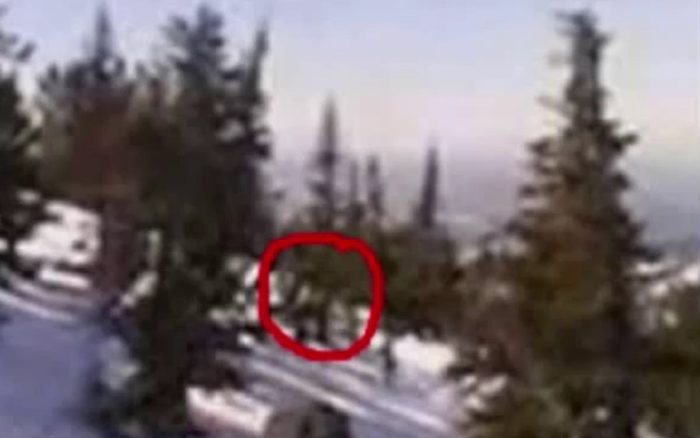
Does this picture show a Yeti?
Other researchers suggest that these sudden disappearances, or becoming invisible, are due to portals or gateways that these creatures travel back and forth from – whether it is a purposeful journey or not.
Might this explain why there are only ever very brief sightings of these elusive creatures? Why they are there one minute, and gone the next? And if these interdimensional trips are purposeful, what does that tell us of the intelligence on the part of Bigfoot and Yetis? And why are they making such journeys from their realm of existence to ours?
Further according to Bykova’s research are the beliefs and claims of Tibetan red-hatted monks. They claim that Yetis have the ability to control its own brain activity – so much so that it can make itself appear invisible. They state that Bigfoot and Yeti creatures are one of the few remaining on Earth who have the ability to do this, suggesting an existence that goes back thousands and thousands of years, at the very least.
A Crossover Of Interests And Research
Again, this would explain why some people claim to see these creatures almost disappear right before their eyes. If there is any truth in the notion that these strange creatures can make themselves “disappear” – whether through a portal unknown to us or through an ancient ability to control the mind to a point untouchable to us – then that means the research must switch somewhat from looking to study an unknown terrestrial animal to examining realms and notions seemingly on the fringes of accepted ideas.
It might even prove that – as some researchers have suggested – that the Bigfoot and Yeti are connected to all strange phenomena and sightings. Whether it be sea monsters, UFOs, or strange disappearances.
In fact, it is perhaps also worth mentioning possible connections to the Missing 411 – strange disappearances and (on occasion) reappearances of people around the North American continent as documented extensively by researcher David Paulides, who has collected accounts going back to the late-1800s.
Many people who have reappeared have spoken of a strange, monstrous-looking, hairy creature with red eyes. While not harming them, these creatures almost act as kidnappers and guards for the duration of their captivity. There are little other details known, but this is a claim that surfaces in many of the strange disappearances of the Missing 411.
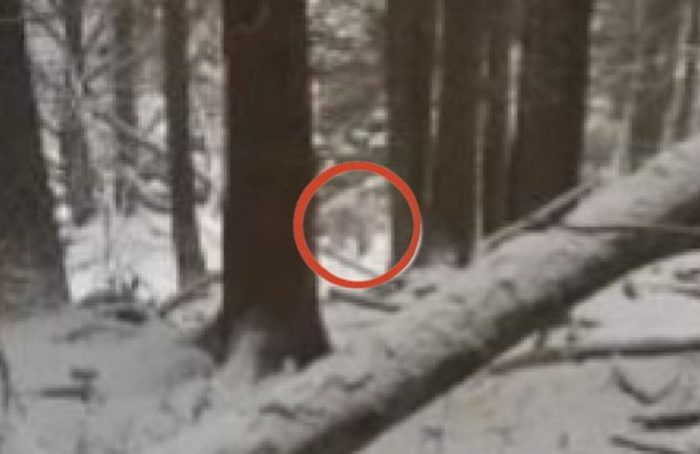
Does this show a real Yeti?
What is also interesting is that many of those disappearances take place in cluster spots, which themselves are in the same locations as both Bigfoot and UFO hotspots. Is there a direct connection between these three things? Or might certain locations simply attract such strange activity, and if so, why?
Might it also prove to be – if a researcher or group of researchers took it upon themselves to do such things – that these disappearances might be taking place through the Eurasia regions and if so, would the correlate to UFO and Bigfoot (or Yeti) sighting hotspots?
Indeed, the more we collectively study one area of interest – in this case, Bigfoot and Yeti encounters – other seemingly unconnected areas become not only relevant but have a little more light cast on them.
The Bigfoot And The Yeti – One And The Same Creature?
There are quite obviously many more questions than answers regarding the Yeti (and Bigfoot) – whatever it might one day prove to be.
Perhaps first of all we should ask if the Bigfoot and the Yeti are the same creature, or a relative to each other? It is worth noting that many of the Yeti sightings in the Eurasia regions speak of these creatures standing at around 6 feet tall. On the other hand, sightings of Bigfoot creatures in the North American continent tend to claim them to be slightly taller – somewhere in the region of 8 feet, which might suggest a cross of the two different “races”. However, this aside, most of the other aspects of the Bigfoot and Yeti are almost identical.
Is this the long-sought-after “missing link” that could explain the evolution of humans in full? Might it be a completely new creature to science – one that appears as much beast-like as it does human? Might the Yetis and Bigfoot of today share a connection to the many hairy and beast-like beings from mythology and folklore from all around the world, stretching back thousands of years? Might there even be, as we have discussed, a supernatural element to these mysterious and mostly elusive creatures?
Although there isn’t an abundance of funds for people to conduct serious research into what these strange creatures are, where they come from, and where they call home, many researchers continue their work regardless. Sightings continue to be logged and recorded, although the answers have so far proven to be as elusive as these strange beast-like entities themselves.
The video below looks at the mysteries of the Yeti in more detail.
References
| ↑1 | Yeti, Sasquatch and Hairy Giants, David Hatcher Childress, ASIN B004XJ4YMO |
|---|---|
| ↑2 | Bigfoot, Rupert Matthews, ISBN 9781848 586154 |
| ↑3 | Yeti: An Abominable History, Graham Hoyland, ISBN 9780008 279523 |
| ↑4 | The Russian Snowman, Paul Stonehill, ParaScope http://www.bigfootencounters.com/creatures/russian.htm |
Fact Checking/Disclaimer
The stories, accounts, and discussions in this article may go against currently accepted science and common beliefs. The details included in the article are based on the reports, accounts and documentation available as provided by witnesses and publications - sources/references are published above.
We do not aim to prove nor disprove any of the theories, cases, or reports. You should read this article with an open mind and come to a conclusion yourself. Our motto always is, "you make up your own mind". Read more about how we fact-check content here.
Copyright & Republishing Policy
The entire article and the contents within are published by, wholly-owned and copyright of UFO Insight. The author does not own the rights to this content.
You may republish short quotes from this article with a reference back to the original UFO Insight article here as the source. You may not republish the article in its entirety.
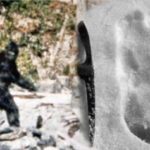
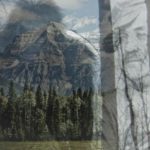

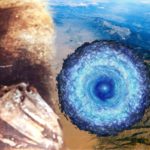

1 Comment
UFO Insight does not take responsibility for the content of the comments below. We take care of filtering profanity as much as we can. The opinions and discussion in the comments below are not the views of UFO Insight, they are the views of the individual posting the comment.
Newest comments appear first, oldest at the bottom. Post a new comment!
In the Vietnam War, there were many Bigfoot-like sightings, these creatures were sometimes called wild men or rock apes. I was stationed in the southern part of South Vietnam, so I never encountered one since the sightings occurred to my north. However, I spoke with several Vietnam Veterans who did encounter these creatures. They told me the ape-men through rocks & attacked the Americans & Viet Cong often. I was disappointed I didn’t get to observe any of these creatures.